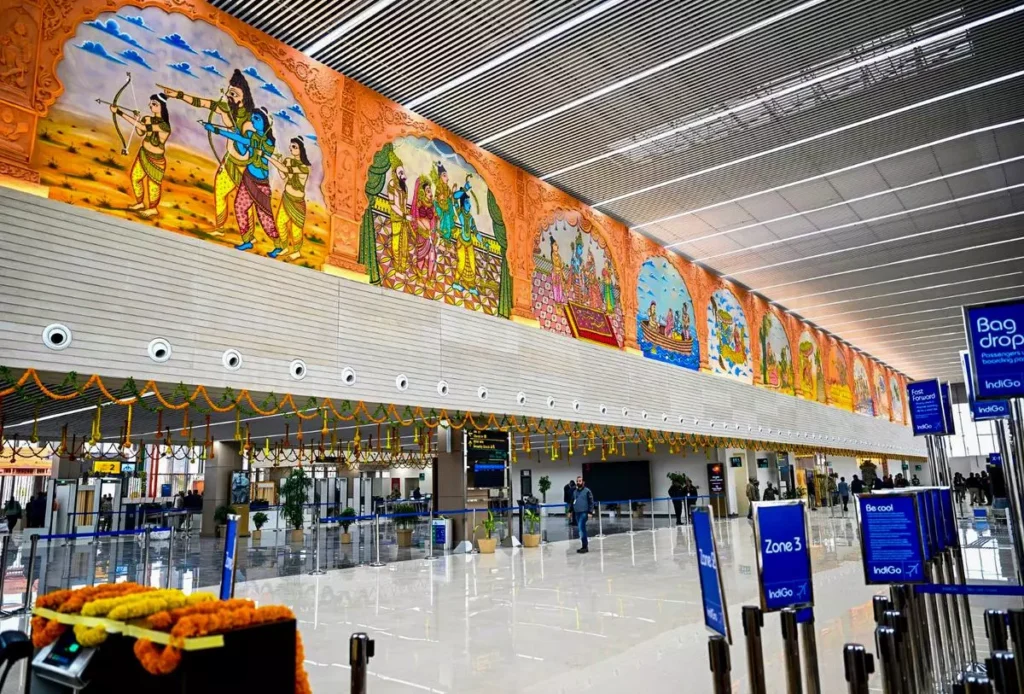“Embark on a Spiritual Journey: Reaching Ayodhya’s Ram Mandir via Maharishi Valmiki Ayodhya International Airport”

The Union Cabinet’s approval to declare the Ayodhya Airport as an international airport and its christening as the Maharishi Valmiki International Airport, Ayodhyadham marks a significant development in Uttar Pradesh’s aviation infrastructure. Prime Minister Narendra Modi inaugurated the airport on December 30, emphasizing its strategic importance in handling the expected surge in travelers to the birthplace of Lord Ram.
- Inauguration and Initial Operations
The airport, officially named the Maharishi Valmiki International Airport Ayodhya Dham, commenced operations with flights connecting it to major cities such as Delhi, Mumbai, Ahmedabad, Bangalore, and Hyderabad. This move is expected to boost tourism to Ayodhya and enhance connectivity for both domestic and international travelers.
- Project Overview
This ambitious project, developed under the Centre’s Regional Connectivity Scheme, Phase-1, comes with an estimated cost of Rs 1,450 crore. Upon completion, the Ayodhya Airport will be Uttar Pradesh’s fifth airport, making it the only state in India with such a distinction. Currently, the state already hosts two functional international airports – Chaudhary Charan Singh International Airport in Lucknow and Lal Bahadur Shastri International Airport in Varanasi. Additionally, work is underway for two more international airports – Kushinagar International Airport in Gorakhpur and Noida International Airport in Jewar.

- Location and Phases
The airport is strategically located 8 km from the Ram Temple along the Gorakhpur-Lucknow National Highway, and it sits 10 km away from the city center. The project will be executed in three phases, covering a vast area of 821 acres. The Airport Authority of India (AAI) is overseeing the construction.
- Phase-wise Development
Phase 1: The ongoing construction includes a 65,000-square-feet terminal with a capacity to handle two-three flights per hour. A 2200-metre runway is being built to accommodate larger aircraft such as Boeing 737, Airbus 319, and Airbus 320.
Phase 2: The terminal will expand to 5 lakh square feet, and the runway will be extended from 2,200 meters to 3700 meters, facilitating the landing of international flights, including Boeing 787 and Boeing 777.
Developer and Design
Bangalore-based Vishal Infrastructure secured the bid for the runway construction. The architectural design of the Ayodhya Airport draws inspiration from the Ramayana era, resembling the Ram temple in elevation. The Nagara style of architecture influences the design, with columns based on the 7 Kandas of the Ramayana.
Harsh Varshney, one of the architects, highlighted the effort to capture the essence of Ramayana and Ayodhya, aiming to bring back the city’s historical charm.
Capacity and Timeline
The new terminal, covering 6,000 sqm, is designed to serve 300 passengers during peak hours, with an annual handling capacity of 6 lakh passengers. The first terminal is expected to be operational by the end of 2023, while the remaining three terminals are scheduled for completion by 2025.
In essence, the Maharishi Valmiki Ayodhya International Airport stands as a symbol of both modern connectivity and cultural preservation, poised to play a crucial role in the region’s economic and tourism development.








